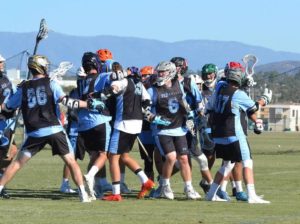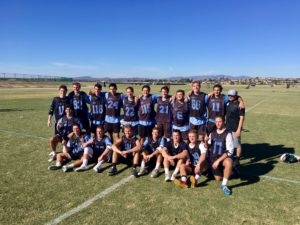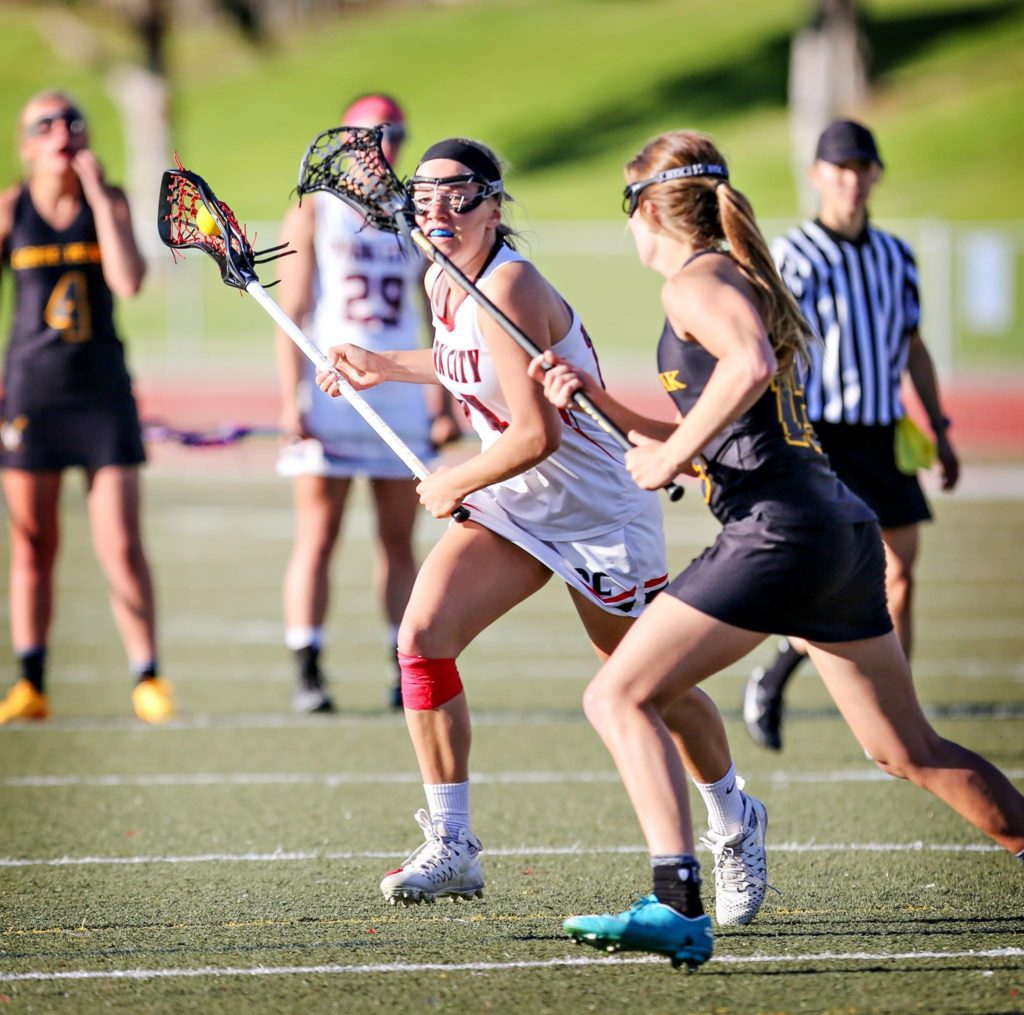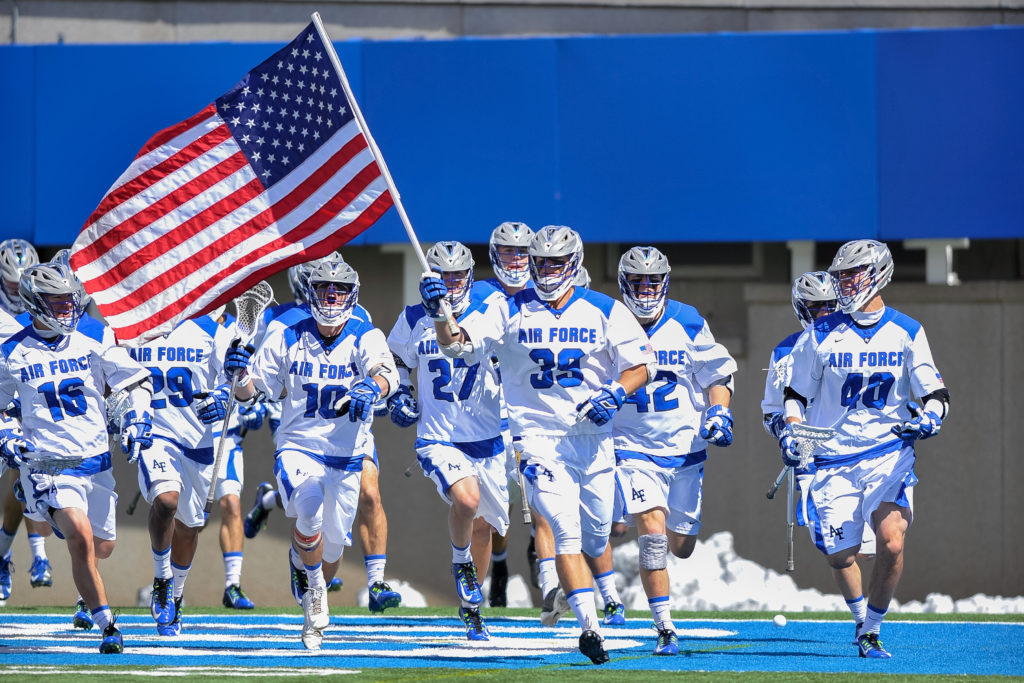2017 Girls’ Youth Lacrosse Rulebook
212 Coach Pat Olmert UNC


The 2007 season finished his 10th full year on the Carolina coaching staff.
Olmert was responsible for coaching the Tar Heels’ goalkeeping corps of Grant Zimmerman, Chris Madalon and Andrew Moss while also working with the team’s man-down defensive unit. In his capacity Olmert helped UNC goalkeeper Paul Spellman become the all-time leader at UNC in career saves in 2005.
Olmert played goalkeeper for North Carolina from 1986 through 1989. He was a freshman on the 1986 NCAA championship team and he also played on the 1988 and 1989 ACC championship teams, the latter year as the team’s starting goalkeeper.
As a senior, Olmert was selected to represent UNC at the 1989 United States Intercollegiate Lacrosse Association North-South All-Star Game.
Olmert still holds the highest career goalkeeper save percentage at UNC with a .663 percentage. He was also on staff as the goalie coach for the 1990 UNC lacrosse team which won the ACC championship and reached the NCAA semifinals. That was the final year of UNC coach Willie Scroggs’ 12-year tenure.
Olmert graduated with a bachelor’s degree in English Literature from the University of North Carolina in 1990. Olmert has since worked full-time as a loan officer for First Financial Services, Inc., in Chapel Hill.
He and his wife Catherine Watkins Olmert, who is a 1990 graduate of UNC, live on Kerr Lake in Manson, N.C. They are the parents of Lucy Catherine Olmert, born September 17, 2002, and twins Brennan and Tucker Olmert, who were born on August 10, 2004.
Olmert is a native of Annapolis, Md. where he attended St. Mary’s High School, graduating in 1985. The following fall he matriculated at UNC and began his long association with the University as lacrosse player, friend of Carolina Lacrosse and assistant coach.
Pat Olmert
• Full Name: Patrick Leonard Olmert
• Born March 7, 1966 in Chevy Chase, Md.
• Married to Catherine Watkins Olmert on September 19, 1992 in Palmer Springs, Va.
• Children: Lucy Catherine Olmert, born September 17, 2002 in Chapel Hill, N.C.; Patrick Brennan Olmert, born August 10, 2004 in Chapel Hill, N.C.; Michael Tucker Olmert, born August 10, 2004 in Chapel Hill, N.C.
College Lacrosse: Recruiting by the Numbers
By Mick Davis
Confession: I am new to the lacrosse world. A former college football player, I have been immersing myself in lacrosse over the past couple months. Having partnered with lacrosse great and thought-leader, Paul Rabil, I’ve been fortunate enough to participate in a number of conversations with some very talented and influential people in the sport. I’m hoping I can channel some of their wisdom here.
Confession Part. 2: I’ve never written anything outside of an academic setting. I’m a little scared, and a little excited, and I hope you like it.
Sports specialization has hit youth sports… Hard. And lacrosse is no exception.
More than 67% of youth lacrosse players play on club or travel teams, with many parents shelling out upwards of $10K annually between registration, travel, equipment, and private lessons. Multiply that over the course of seven years, and we’re talking about some serious dough.
And money isn’t the only consideration. According to US Lacrosse, >70% players 15-and-under participate in private coaching or training, with 50% of boys and 35% of girls playing for more than one team in a season.
Playing sports for your middle or high school isn’t all that challenging logistically; you literally just have to stick around after the last bell sounds – maybe hop on the bus to go play a game – and eventually head back home the same way you would have if you weren’t participating.
Club teams and private lessons are an entirely different ball game (sorry…). Many parents are looking at frequent long drives to scattered training centers and field space, oftentimes during difficult hours, and let’s not forget about sacrificing weekends and vacation opportunities. It takes resources and real commitment on the part of both players and parents.
This all begs the question – why? I would posit that there are many and varied reasons, and that each family’s decision is a bit different than the next. While I won’t address them all here, I would like to address one that is top-of-mind in the sports world: a shot playing college lacrosse and a piece of that sweet scholarship money.
Acceptance rates for colleges are at an all-time low and tuition is at an all-time high. This is especially true in America’s elite institutions, which are historically attractive in terms of lacrosse competition, as well as opening doors after play has ended. It’s no surprise that competition is fierce for existing roster spots, thereby pushing top players and families to pursue extra training to remain in contention.
So, what are the odds of making it onto a college roster or getting athletic-based financial aid? The road to college sports can be as mysterious as it is difficult to navigate. Plagued by a shadowed mythos around recruitment and scholarships, it’s easy to get lost; let’s try and cut through the noise with some numbers.
In 2015, the NCAA estimated that high school boys had a 2.9% chance of playing for a Division I program, 2.2% for Division II, and 7.1% for Division III. For girls, it was 3.7% chance for Division I, 2.5% for Division II, and 6.7% chance for Division III.
In total, high school boys had a 12.1% chance of playing college lacrosse at some level; girls had a 13% chance. Put simply: roughly 1 out of every 8 high school lacrosse players will go on to play in college.
And for the sake of psychological equality: 7 out of 8 high school players will not go on to play in college.
Note: There are additional roster spots in the Men’s Collegiate Lacrosse Association (MCLA) and National Association of Intercollegiate Athletics (NAIA). I’ve been unable to uncover whether MCLA athletes receive admissions help, and would love to know if you have the answer. NAIA schools do recruit, and even have athletic scholarships. Due to the relatively small number of players across the NAIA, the data doesn’t change much if included. I tried weaving them into the article and things got messy quickly. No hard feelings, MCLA and NAIA. I see you.
While the chances of making a roster might feel low – especially if you’re a data nerd like me – these odds are some of the highest across college sports. Only 3.5% of high school basketball players will go on to play in the NCAA, volleyball is sitting strong at 3.9%, and football is 6.7%. In fact, the only sport listed with a higher probability of participation than men’s and women’s lacrosse is women’s ice hockey (23.1%), which my hypothetical daughter is being enrolled in as we speak.
Now getting into the tricky business of scholarships. First some background:
There are six sports in the NCAA (Division I only) where full-ride scholarships are likely to be found: football, men’s & women’s basketball, tennis, gymnastics, and volleyball. These are called head count sports. Each school receives an allotment of full scholarships, each of which may only be designated to a single student-athlete. Example: A Division I men’s basketball team has 13 scholarships, meaning there are 13 players on the roster with up to full-ride scholarships, and the remainder get nothing.
Lacrosse is what’s called an equivalency sport. What’s that mean? Similar to head count sports, each school is allotted a number of full scholarships. However, the total value of these scholarships can be distributed across any number of players. In effect, you end up with many players getting partial scholarships, VERY few getting full scholarships, and many receiving no athletic aid.
NCAA Divisions I and II grant scholarships for lacrosse – everybody except for Division III. The chance of securing a roster spot at a scholarship-granting school for men is 5.5% and 6.7% for girls; the odds of securing a scholarship is even smaller (see: equivalency sport).
For those keeping score at home, (very roughly) 1 in 20 high school lacrosse players will play in college and receive some level of athletic scholarship.
I think the math demonstrates a few things:
(1) Access to scholarship money is not steering the ship.
Parents are paying for lacrosse in a way that far outsizes the economic benefit of available scholarships. There are exceptions to the rule. Little Johnny, the 6’4” 8th grade phenom with a 38” vertical leap might one day receive that elusive lacrosse full ride, and it’s probably in the interest of Johnny and his family to stoke that flame. For the majority, the numbers don’t add up.
(2) College admission is more important than scholarships, but not the most important.
The value of a 4-year college degree at an elite school outweighs any scholarship award by leaps and bounds. The increase in earnings potential alone dwarfs any savings by comparison. Elite Division III and Ivy League schools do not offer athletic scholarships, yet remain some of the most sought after teams for lacrosse families. The thousands that parents are paying out isn’t saying “let’s see if we can get some tuition money here,” it’s saying “I want my kid to go to that school – and here’s a way to take a swing”.
(3) It’s not all about the money.
Personal economics are important factors for families when planning their lives, but there’s more at stake than numbers – and the numbers prove that.
Team sports provide an opportunity to grow interpersonal skills, practice healthy habits, develop leadership, and instill work ethic. Additionally, in a world of increasing social withdrawal, club teams provide a unique family-based community that can be tough to find elsewhere. And for many parents, it’s just a good excuse to get their kids away from their screens and out doing something productive.
So what is important…?
Know what your goals are, research, and communicate.
For players: Am I ready for the dedication required to give myself a chance for success? Am I doing this for the right reasons? Do I love lacrosse enough to elevate that dedication for four more years? (hint: college lacrosse is a job)
For parents: Does my child want to play college lacrosse? Does my child possess the necessary traits to succeed as a college athlete? What is the best program for us based on our goals?
The landscape is tricky to navigate, and setting expectations appropriately as coaches and educators in the sport is perhaps more important than parental diligence; whereas a parent can affect a few children, a coach or educator can affect many.
Do your homework. Make your decision. Feel good about it.
212 Wins 20th Tournament Championship




FOR IMMEDIATE RELEASE
Contact:
Christa Graff
Graff Public Relations
435-640-7921
christa@graffpr.com
212 Lacrosse, based out of Park City, participated in the 3D Oceanside
Tournament this past weekend in beautiful San Diego, California. The tournament attracted 100+ teams and 40 college recruiters with outstanding competition. 212 fielded teams in the 2019 and 2017 Elite division with players spanning grades 9-12.
The teams were led by UNC Tar Heel Mike Acee, Westminster’s Christian Pompoco and Thomas Sarjeant.
The 2019 boys’ team finished the weekend with a 3-2 record. Their losses came to eventual tournament champion ADVNC team led by former UVA All – American Chris Rotelli and a tough one goal loss to So Cal Express led by Hall of Fame inductee Glenn Miles.
The 212 Elite team finished the weekend in the top division with a perfect 5-0 record, culminating the weekend with 212’s 20th tournament championship. The team notched wins over 3D Oregon 13-5 in the semifinals and 3D San Diego 12-11 in the championship game.
The cumulative totals for 212 in San Diego were 82 goals for and 44 against while recording 8 wins and 2 losses.
“I’m extremely proud of all the 212 kids. As always, a big thank you to the entire 212 community. The support the parents show myself and our staff is tremendous. I’d also like to thank Christian Pompoco and Thomas Sarjeant for an excellent weekend of coaching and the 3D staff for organizing a well run, fun event for the kids.”
212 has a cumulative four-year record of 189-48 and 20 tournament championships, with 37 players committing to play Division I lacrosse.
212 Player Gabby Nixon Commits to Marist College

- « Previous Page
- 1
- …
- 21
- 22
- 23
- 24
- 25
- …
- 47
- Next Page »

